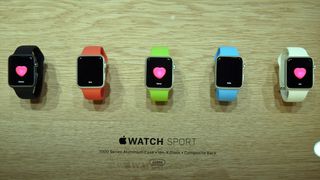How the Apple Watch will be good for businesses
Apple's smartwatch could follow the lead of the iPad

Traditionally, Apple has never been a company focused on enterprise. As Steve Jobs said in his iPhone announcement, Apple aimed for the intersection between technology and liberal arts and, as such, has become a firm favourite with those who work creatively for a living (or, as Apple likes to put it, those who "Think Differently") instead of working crunching numbers in an office, which is the domain of Microsoft and IBM.
Enterprise matters
With the arrival of the iPhone and iPad, Apple has been thrust into the world of enterprise – willingly, or otherwise. iOS has been constantly kept ahead of Android and Windows Phone in terms of security and compatibility with existing enterprise software and, as such, Apple has been rewarded: companies are starting to issue iPhones as default company phones instead of BlackBerries.
Almost all of the top Fortune 500 companies use an iOS product (usually the iPad), and Macs are gaining significance in both enterprise and consumer fields, seeing sales growth in a rapidly shrinking PC industry. In 2014, Apple's relationship with enterprise is looking good.
And it is likely only going to get better as we head into 2015 and Apple releases the Apple Watch, a device which is likely to be a massive hit with businesses.
Time saver
While some will dismiss the Apple Watch as a gimmick, savvy businesses will latch onto the time saving elements of the Watch. A 'Sport' version of the Watch – starting at $349 (around £220, AU$400) – has the exact same software as the 'Edition' version, which comes in various gold liveries (and is likely to cost up to $2,500 or around £1,550, AU$2,850). The software, of which only a small sample has been shown, has many of the staple features that come with a smartwatch now, including the ability to field notifications without interacting with a phone.
The idea of not having to interact with a phone is key, especially given Apple's moves towards this with OS X 10.10 Yosemite and the increased push for (seamless) integration between iOS and the Mac. If your iPhone is near your Mac, a Wi-Fi hotspot can be created without interacting with the phone – and similar ideas are likely to be introduced into the Watch, saving valuable time which can then be spent on work.
The Watch will likely be integrated with iOS and OS X in the same way as the iPhone is integrated with OS X, performing functions wirelessly and without friction. A reminder, set up in Apple's Reminders app, could show only on the Watch if it senses the phone is out of reach or in a pocket, for example. While this may seem like a gimmick at first, the time saved will be valuable to businesses which run on a tight schedule and for individuals who need access to upcoming events promptly.
Are you a pro? Subscribe to our newsletter
Sign up to the TechRadar Pro newsletter to get all the top news, opinion, features and guidance your business needs to succeed!
As VP of Design Jony Ive says in the introductory video for the Apple Watch, apps on the Apple Watch are "designed for lightweight interaction," with 'Smart Replies' shown as a demo of the Watch and iPhone working together to speed up a process, in this case texting.
Apple Pay integration
From a sales perspective, Apple Watch is also useful in terms of its integration with Apple Pay. Released less than a month ago, Apple Pay allows a user to wirelessly pay for items – both online and offline – with Touch ID and an NFC-enabled till. Currently, Apple Pay only works at a till with the iPhone, but incorporating the technology into a smartwatch makes the process far more seamless and will, ultimately, lead to more transactions due to its ease of use.
While it was only released recently, Apple Pay has been making waves with a conglomerate of big retailers moving to 'block' the service by switching off NFC at their tills in order to cut out the 3-4% fees that credit card companies charge per transaction. While we are some way from Apple releasing solid user figures for Apple Pay (the service is currently only available in the US, for a start), this is a clear indication that customers are using the service, a first for an NFC-based payment system.
Max Slater-Robins has been writing about technology for nearly a decade at various outlets, covering the rise of the technology giants, trends in enterprise and SaaS companies, and much more besides. Originally from Suffolk, he currently lives in London and likes a good night out and walks in the countryside.
